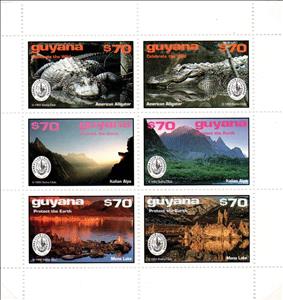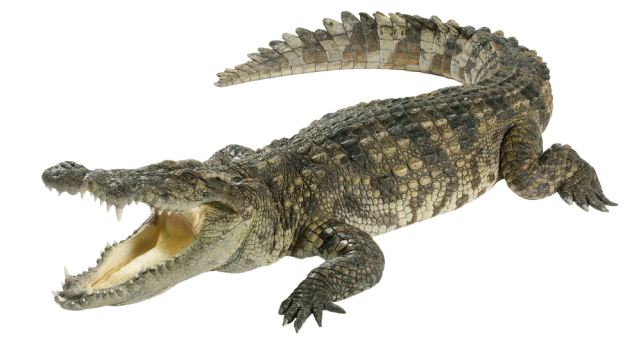Mini Sheet: Alligator, Alligator, etc. (Guyana 1994)
Alligator, Alligator, etc. (Guyana 1994)
20 May (Guyana ) within release Centenary of the Sierra Club goes into circulation Mini Sheet Alligator, Alligator, etc. face value 6*70 Guyanese dollar
| Mini Sheet Alligator, Alligator, etc. in catalogues | |
|---|---|
| Stanley Gibbons: | Sg: GY 3858a |
Mini Sheet is square format.
Also in the issue Centenary of the Sierra Club:
- Mini Sheet - Kangaroo with young, Alligator, etc. face value 8*70;
- Mini Sheet - Sea Lions, etc. face value 9*70;
- Mini Sheet - Kangaroo, Whooping Crane, etc. face value 8*70;
- Mini Sheet - Alligator, Alligator, etc. face value 6*70;
- Stamp - Alaskan Brown Bear and Cub face value 70;
- Stamp - Alaskan Brown Bear Fishing face value 70;
- Stamp - Alaskan Brownbear face value 70;
- Stamp - American Alligator (Logo at Left) face value 70;
- Stamp - American Alligator (Logo at Right) face value 70;
- Stamp - Bald Eagle face value 70;
- Stamp - Bald Eagle on Branch face value 70;
- Stamp - Clouds over Matterhorn face value 70;
- Stamp - Giant Panda face value 70;
- Stamp - Giant Panda Eating Bamboo face value 70;
- Stamp - Head of American Alligator face value 70;
- Stamp - Head of Bald Eagle face value 70;
- Stamp - Head of Bald Eagle face value 70;
- Stamp - Head of Giant Panda face value 70;
- Stamp - Head of Sea Lion face value 70;
- Stamp - Italian Alps and Meadow face value 70;
- Stamp - Italian Alps at Sunrise face value 70;
- Stamp - Lake, Italian Alps face value 70;
- Stamp - Matterhorn and Village face value 70;
- Stamp - Mono Lake at Sunset face value 70;
- Stamp - Red Kangaroo face value 70;
- Stamp - Red Kangaroo with Young face value 70;
- Stamp - Rock Pinnacles, Mono Lake face value 70;
- Stamp - Rock Pinnacles, Mono Lake face value 70;
- Stamp - Sea Lion face value 70;
- Stamp - Sea Lions on Rocks face value 70;
- Stamp - Sierra Club Centennial Emblem face value 70;
- Stamp - Summit of Matterhorn face value 70;
- Stamp - Whooping Crane Facing Left face value 70;
- Stamp - Whooping Crane in Courtship Display face value 70;
- Stamp - Whooping Crane Looking Right face value 70;
Mini Sheet Alligator, Alligator, etc. it reflects the thematic directions:
Animals are multicellular, eukaryotic organisms of the kingdom Animalia (also called Metazoa). All animals are motile, meaning they can move spontaneously and independently, at some point in their lives. Their body plan eventually becomes fixed as they develop, although some undergo a process of metamorphosis later on in their lives. All animals are heterotrophs: they must ingest other organisms or their products for sustenance.
Crocodiles (family Crocodylidae) or true crocodiles are large semiaquatic reptiles that live throughout the tropics in Africa, Asia, the Americas and Australia. The term crocodile is sometimes used even more loosely to include all extant members of the order Crocodilia, which includes the alligators and caimans (family Alligatoridae), the gharial and false gharial (family Gavialidae) among other extinct taxa.
A landscape is the visible features of an area of land, its landforms and how they integrate with natural or man-made features. A landscape includes the physical elements of geophysically defined landforms such as (ice-capped) mountains, hills, water bodies such as rivers, lakes, ponds and the sea, living elements of land cover including indigenous vegetation, human elements including different forms of land use, buildings and structures, and transitory elements such as lighting and weather conditions. Combining both their physical origins and the cultural overlay of human presence, often created over millennia, landscapes reflect a living synthesis of people and place that is vital to local and national identity. The character of a landscape helps define the self-image of the people who inhabit it and a sense of place that differentiates one region from other regions. It is the dynamic backdrop to people’s lives. Landscape can be as varied as farmland, a landscape park, or wilderness. The earth has a vast range of landscapes, including the icy landscapes of polar regions, mountainous landscapes, vast arid desert landscapes, islands and coastal landscapes, densely forested or wooded landscapes including past boreal forests and tropical rainforests, and agricultural landscapes of temperate and tropical regions.
Reptiles are tetrapod (four-limbed vertebrate) animals in the class Reptilia, comprising today's turtles, crocodilians, snakes, amphisbaenians, lizards, tuatara, and their extinct relatives. The study of these traditional reptile orders, historically combined with that of modern amphibians, is called herpetology. Because some reptiles are more closely related to birds than they are to other reptiles (e.g., crocodiles are more closely related to birds than they are to lizards), the traditional groups of "reptiles" listed above do not together constitute a monophyletic grouping (or clade). For this reason, many modern scientists prefer to consider the birds part of Reptilia as well, thereby making Reptilia a monophyletic class.




